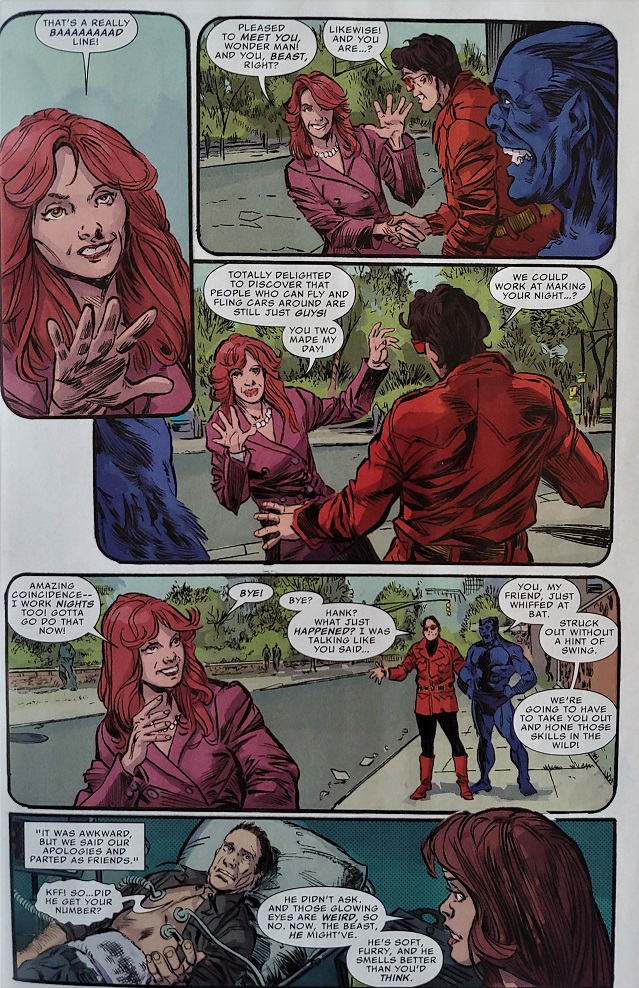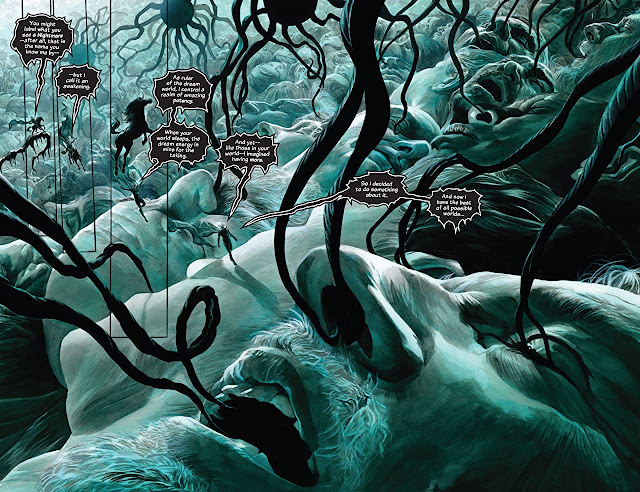In 1941, a small publisher by the name of Timely Comics, released the adventures of a certain star-spangled hero that served both as an American propaganda outside the US but also as an example of patriotism in the convulsive times of World War II. Captain America was created to fight the Nazis and to defeat Hitler, and he was born when America and the world needed him the most. 80 years have passed since the creation of this character and although much has been said about his recent exploits, people tend to forget the original stories from the 40s.
Perhaps as a way to remind readers of stories of yesteryear, or perhaps simply as an anniversary homage, Marvel Comics decided to adapt those first stories in a very interesting way, by having the best industry artists drawing different pages while preserving the original dialogs by Joe Simon and Stan Lee. The result is a beautiful comic book in which every page is a glorious example of the creativity and talent of today’s comic book artists. True, some people might miss the original Jack Kirby pages, but hey, those have been reprinted on multiple occasions and can be easily found online and in print.
 |
| John Cassaday |
The cover of the issue is based on Jack Kirby’s iconic Avengers # 4 (March 1964), that marks the reintroduction of Captain America in the modern Marvel Universe, after decades of hibernation. Artist Steve McNiven maintains Kirby’s composition, adding important details to the background as well as expression lines in the faces of Marvel’s most famous superheroes. This comic, however, doesn’t start with the Avengers adventure but rather with the original comic book (March 1941) and the splash page is wonderfully illustrated by John Cassaday, an artist who’s been involved with Captain America, in one way or another, for over 20 years now.
 |
| Salvador Larroca |
In subsequent pages of the origin issue we have people like Salvador Larroca and Paul Renaud (by the way, the dialogue in this page is hilarious: just see the second panel when Captain America gets angry at Bucky and says “I ought to tan your hide!”, nowadays people would be screaming and accusing the hero of being abusive, or too violent with children or who knows what, but in 1940, this was perfectly normal. In the next story we see the first appearance of Red Skull, and here Inhyuk Lee’s page is very impressive.
Then we have the actual Avengers comic, which is not only the longest but also the only one connected to the Marvel Universe, and so here in the splash page, beautifully illustrated by Jim Cheung we see Earth’s mightiest heroes. Alex Ross ads hyperrealism to the first encounter of the Sentinel of Liberty and the Avengers. Finally the page by Ray-Anthony Height is so vivid and colorful, and so full of energic.
 |
| Paul Renaud |
Other artists that participate in this special tribute were Marguerite Sauvage, David Lapham, Peach Momoko, Declan Shalvey, Pere Pérez, Juann Cabal, Carmen Carnero, Valerio Schiti, Kei Zama, Jesús Saiz, Adam Kubert, Joshua Cassara, Dean White, Leinil Francis Yu, Sunny Gho, Carlos Pacheco, Rafael Fonteriz, R.B. Silva, Sara Pichelli, Kim Jacinto, Federico Vicentini, Mahmud Asrar, Joe Bennett, Steve Epting, Stephanie Hans, Alitha E Martínez, Paco Medina, Chris Samnee, Rachel Stott, Greg Smallwood, Iban Coello, Natacha Bustos, Patrick Gleason, Terry Dodson, Rachel Dodson, Alex Sinclair, Adam Hughes, Javier Garrón, Elena Casagrande, Daniel Acuña, Butch Guice, Pepe Larraz, Greg Land, Jay Leisten and Mark Bagley. What an extraordinary list!
________________________________________________________________________________________________________
________________________________________________________________________________________________________
En 1941, una pequeña editorial con el nombre de Timely Comics, publicó las aventuras de cierto héroe de rayas y estrellas que sirvió como propaganda estadounidense fuera de los Estados Unidos pero también como ejemplo de patriotismo en los convulsos tiempos de la Segunda Guerra Mundial. El Capitán América fue creado para luchar contra los nazis y derrotar a Hitler, y nació cuando Estados Unidos y el mundo más lo necesitaban. Han pasado 80 años desde la creación de este personaje y aunque se ha hablado mucho de sus hazañas recientes, la gente tiende a olvidar las historias originales de los 40s.
 |
| Inhyuk Lee |
Quizás como una forma de recordar a los lectores historias de antaño, o quizás simplemente como un homenaje de aniversario, Marvel Comics decidió adaptar esas primeras historias de una manera muy interesante, pidiéndoles a los mejores artistas de la industria que dibujaran diferentes páginas conservando los diálogos originales de Joe Simon y Stan Lee. El resultado es un hermoso cómic en el que cada página es un ejemplo glorioso de la creatividad y el talento de los artistas del cómic de hoy. Es cierto que algunas personas pueden echar de menos las páginas originales de Jack Kirby, pero bueno, se han reeditado en múltiples ocasiones y se pueden encontrar fácilmente en línea e impresas.
 |
| Jim Cheung |
La portada del número se basa en el icónico Avengers # 4 (marzo 1964) de Jack Kirby, que marca la reintroducción del Capitán América en el Universo Marvel moderno, después de décadas de hibernación. El artista Steve McNiven mantiene la composición de Kirby, agregando detalles importantes al fondo, así como líneas de expresión en los rostros de los superhéroes más famosos de Marvel. Este cómic, sin embargo, no comienza con la aventura de los Vengadores, sino más bien con el cómic original (marzo 1941) y la página de inicio está maravillosamente ilustrada por John Cassaday, un artista que ha estado involucrado con el Capitán América, de una forma u otra, durante más de 20 años.
 |
| Alex Ross |
En las páginas siguientes tenemos a personas como Salvador Larroca y Paul Renaud (por cierto, el diálogo en esta página es divertidísimo: solo mirad la segunda viñeta cuando el Capitán América se enoja con Bucky y dice “Debería azotarte hasta dejarte la piel bronceada”, hoy en día la gente estaría gritando y acusando al héroe de ser abusivo, o demasiado violento con los niños o quién sabe qué, pero en 1940, esto era perfectamente normal. En la siguiente historia vemos la primera aparición de Red Skull, y aquí la página de Inhyuk Lee es muy impresionante.
Luego tenemos el cómic de los Vengadores, que no sólo es el más largo sino también el único conectado al Universo Marvel, y aquí en la página de inicio, bellamente ilustrada por Jim Cheung, vemos a los héroes más poderosos de la Tierra. Alex Ross agrega hiperrealismo al primer encuentro entre el Centinela de la Libertad y los Vengadores. Finalmente, la página de Ray-Anthony Height es tan vívida y colorida, y tan llena de energía.
 |
| Ray-Anthony Height |
Otros artistas que participaron de este homenaje especial fueron Marguerite Sauvage, David Lapham, Peach Momoko, Declan Shalvey, Pere Pérez, Juann Cabal, Carmen Carnero, Valerio Schiti, Kei Zama, Jesús Saiz, Adam Kubert, Joshua Cassara, Dean White, Leinil Francis Yu, Sunny Gho, Carlos Pacheco, Rafael Fonteriz, RB Silva, Sara Pichelli, Kim Jacinto, Federico Vicentini, Mahmud Asrar, Joe Bennett, Steve Epting, Stephanie Hans, Alitha E Martínez, Paco Medina, Chris Samnee, Rachel Stott, Greg Smallwood , Iban Coello, Natacha Bustos, Patrick Gleason, Terry Dodson, Rachel Dodson, Alex Sinclair, Adam Hughes, Javier Garrón, Elena Casagrande, Daniel Acuña, Butch Guice, Pepe Larraz, Greg Land, Jay Leisten y Mark Bagley. ¡Qué lista tan extraordinaria!











































